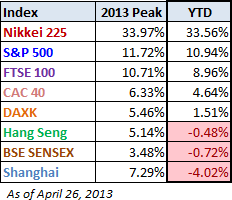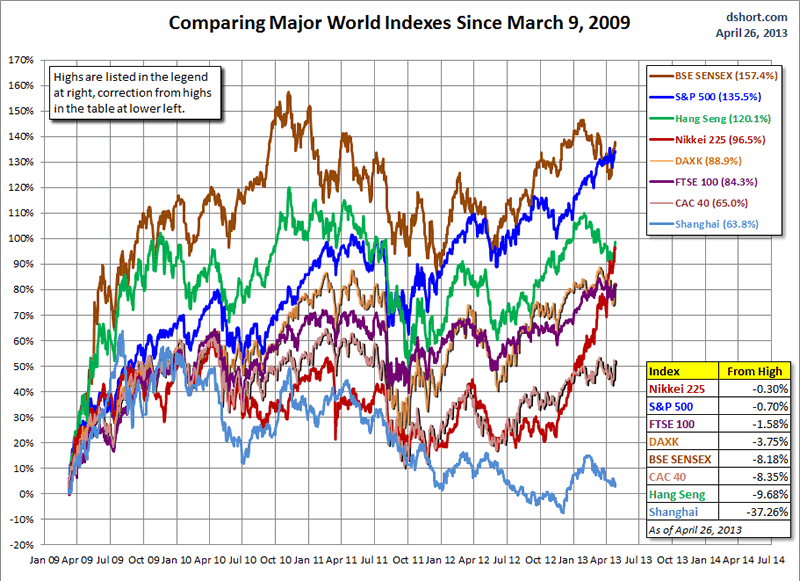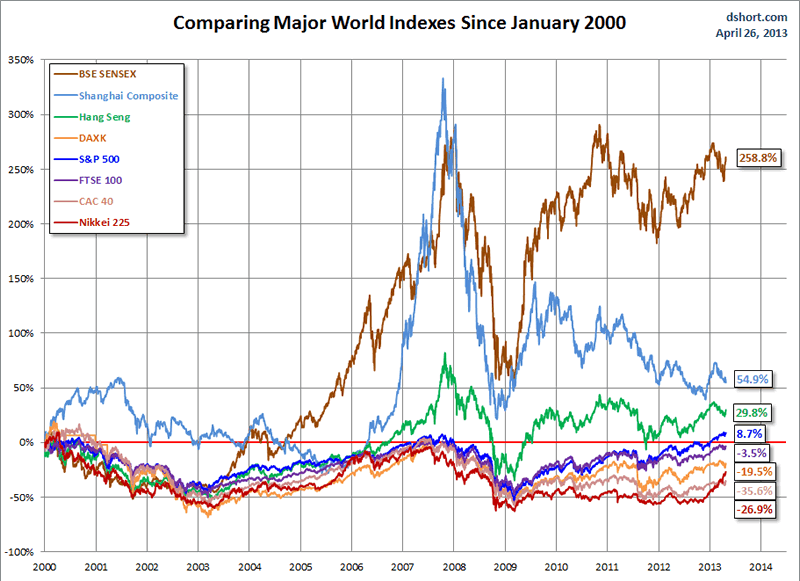Stock Market Rally on Steriods (Except for China)
Stock-Markets / Stock Markets 2013 Apr 28, 2013 - 06:32 PM GMTBy: PhilStockWorld
 Courtesy of Doug Short: The worldwide rally continued last week. Seven of the eight indexes on my watchlist posted big gains. The lone loser was the Shanghai Composite, down three percent (2.97% to be precise). How well did the other indexes perform? Well, the average of the seven winners was a three percent increase (2.99% at two decimal places). Germany’s DAXK was the top finisher, up 4.5%. France’s CAC 40 and Japan’s Nikkei also finished with gains of more than four percent. The S&P 500′s 1.74% gain was only good enough for sixth place. That was quite a week, thanks to hopes of more central bank intervention.
Courtesy of Doug Short: The worldwide rally continued last week. Seven of the eight indexes on my watchlist posted big gains. The lone loser was the Shanghai Composite, down three percent (2.97% to be precise). How well did the other indexes perform? Well, the average of the seven winners was a three percent increase (2.99% at two decimal places). Germany’s DAXK was the top finisher, up 4.5%. France’s CAC 40 and Japan’s Nikkei also finished with gains of more than four percent. The S&P 500′s 1.74% gain was only good enough for sixth place. That was quite a week, thanks to hopes of more central bank intervention.
 The Shanghai remains the only index on the watch list in bear territory — the traditional designation for a 20% decline from an interim high. See the table inset (lower right) in the chart below. The index is down over 37% from its interim high of August 2009. At the other end of the inset, Japan’s stimulus-driven Nikkei closed the week a mere 0.30% off its interim high set on the previous close.
The Shanghai remains the only index on the watch list in bear territory — the traditional designation for a 20% decline from an interim high. See the table inset (lower right) in the chart below. The index is down over 37% from its interim high of August 2009. At the other end of the inset, Japan’s stimulus-driven Nikkei closed the week a mere 0.30% off its interim high set on the previous close.
Here is a table highlighting the 2013 year-to-date gains, sorted in that order, along with the 2013 interim highs for the eight indexes. The sustained advance of the Japan’s Nikkei puts it solidly in the top spot with three times the gain of the second place S&P 500. While the Nikkei is the top performer, its three Asia-Pacific neighbors, Hong Kong’s Hang Seng, China’s Shanghai Composite and India’s SENSEX, along with Germany’s DAXK, have performed the worst in 2013, all with YTD losses. The DAXK was also in the red YTD last week, but its 4.5% surge over the past five sessions put it back in the green.
A Closer Look at the Last Four Weeks
The tables below provide a concise overview of performance comparisons over the past four weeks for these eight major indexes. I’ve also included the average for each week so that we can evaluate the performance of a specific index relative to the overall mean and better understand weekly volatility. The colors for each index name help us visualize the comparative performance over time.

The chart below illustrates the comparative performance of World Markets since March 9, 2009. The start date is arbitrary: The S&P 500, CAC 40 and BSE SENSEX hit their lows on March 9th, the Nikkei 225 on March 10th, the DAX on March 6th, the FTSE on March 3rd, the Shanghai Composite on November 4, 2008, and the Hang Seng even earlier on October 27, 2008. However, by aligning on the same day and measuring the percent change, we get a better sense of the relative performance than if we align the lows.

A Longer Look Back
Here is the same chart starting from the turn of 21st century. The relative over-performance of the emerging markets (Shanghai, Mumbai SENSEX, Hang Seng) is readily apparent, especially the SENSEX, but the trend over the past two years has not been their friend (make that three years for the Shanghai).

Check back next week for a new update.
- Phil
Philip R. Davis is a founder of Phil's Stock World (www.philstockworld.com), a stock and options trading site that teaches the art of options trading to newcomers and devises advanced strategies for expert traders. Mr. Davis is a serial entrepreneur, having founded software company Accu-Title, a real estate title insurance software solution, and is also the President of the Delphi Consulting Corp., an M&A consulting firm that helps large and small companies obtain funding and close deals. He was also the founder of Accu-Search, a property data corporation that was sold to DataTrace in 2004 and Personality Plus, a precursor to eHarmony.com. Phil was a former editor of a UMass/Amherst humor magazine and it shows in his writing -- which is filled with colorful commentary along with very specific ideas on stock option purchases (Phil rarely holds actual stocks). Visit: Phil's Stock World (www.philstockworld.com)
© 2013 Copyright PhilStockWorld - All Rights Reserved Disclaimer: The above is a matter of opinion provided for general information purposes only and is not intended as investment advice. Information and analysis above are derived from sources and utilising methods believed to be reliable, but we cannot accept responsibility for any losses you may incur as a result of this analysis. Individuals should consult with their personal financial advisors.
PhilStockWorld Archive |
© 2005-2022 http://www.MarketOracle.co.uk - The Market Oracle is a FREE Daily Financial Markets Analysis & Forecasting online publication.



